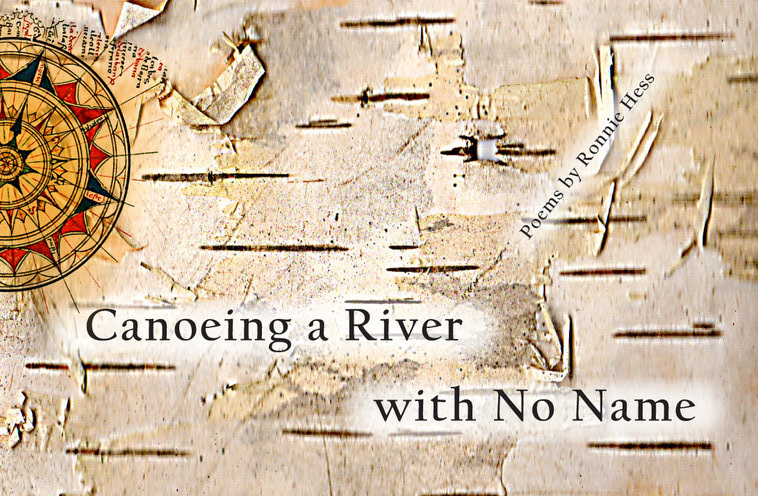
Canoeing a River with No Name by Ronnie Hess. Bent Paddle Press, 2018
Reviewed by Judy Barisonzi
As I write this, my canoe is still hanging in the garage for the winter, the season for lakes and rivers yet a distant dream. That reality makes the title of this collection, Canoeing a River with No Name, all the more alluring. I could enjoy just looking at this beautifully crafted little book, designed by Steve Tomasko and produced by Bent Paddle Press, with its cover like birch bark, its inner covers deep blue like a summer lake, and a cryptic compass rose adorning its pages. Measuring seven and a half inches by not quite five, the chapbook suggests a map to a different world, providing both physical and spiritual guidance. And that’s exactly what it is.
The booklet is divided into a brief prologue about the Kickapoo River in Wisconsin plus three main sections, each devoted to a different river: the Spanish River, whose location I don’t know; the river with no name of the book title; and the Douro in Portugal. The section on the Spanish River reads like the diary of a trip of exploration, but although the poems present mundane details, their titles—”The Voyage Out,” “Toward Wilderness,” “Interior Landscape”—also suggest a journey inward. On this journey, “hours have no numbers” (p. 11), as the poet travels into “the mind’s darkened spaces” (p. 14).
From these two physical trips, we move into “a river with no name,” a trip not along a waterway, but into the experience of a cancer scare—the clinic, a lump, denial, tests. Like the physical river trips, this new journey offers danger, dislocation, and fear of death. “What will you do when your luck runs out?” asks the epigraph for the book, and Hess continues to ask questions: “What if my body fails me” (p. 22); “Who doesn’t search out the unknown?” (p. 23); “Would I want to be the last to let go?” (p. 25), and finally, “Do we never know / the end of the story?” (p. 29). “Something addles the compass points” (p. 29) writes Hess, and she concludes: “We are all travelers in the dark. / Some of us are better at it than others” (p. 30).
Finally we move on, this time to Portugal, in the section titled “Canoeing Beyond the Douro.” Stranded in a snowstorm in the mountains, Hess never reaches the Douro, and she concludes “everything is about faith, about leaping” (p. 33). She asks more questions—“Is it better to follow a wanderer’s calendar?” (p. 39)—but she knows the answers. It’s better to be like the cat, who “licks one paw at a time” (p. 41).
Ronnie Hess’s language throughout Canoeing a River with No Name is simple, direct, concrete, but the themes of time and journey are woven together in complex ways that repay rereading. Though canoeing is its metaphor, essentially the book is about survival, affirmation, and love. So prepare your canoe for spring, and as you pack for the first river journey of the season, slip this small volume into your pack to serve as your compass, your atlas, your “rough guide to the universe” (p. 43) that awaits you.